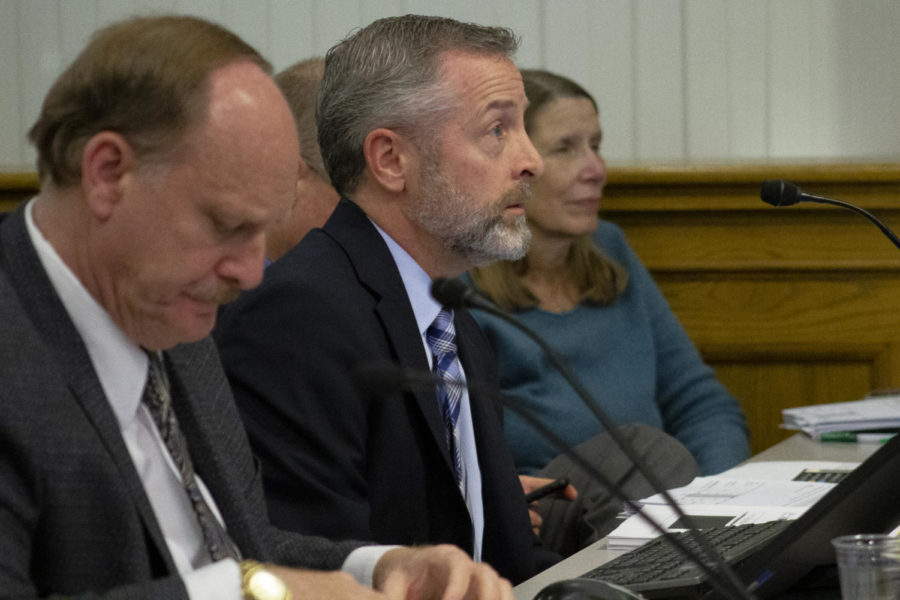City unveils $207 million capital improvements plan
Kennedy DeRaedt/Iowa State Daily
Staff members from the city of Ames present during the Ames City Council meeting. Ames City Council met Jan. 15 in City Hall to discuss the 2019-2024 Capital Improvements Plan. Staff members gave a presentation on their recommendations for the next five years.
January 15, 2019
Electric buses, infrastructure improvements and a $2 million public safety radio system were discussed Tuesday night as part of the city’s five-year Capital Improvements Plan (CIP).
Ames city staff presented the 150-page plan to the city council at their weekly meeting. The CIP includes more than $207 million in project costs, which would pull from different local, state and federal monetary funds.
The CIP isn’t finalized yet. The staff will be able to make decisions now that the plan has been disclosed to them, and opportunities for public input will be held before the decision making process is complete.
City planning staff revealed the plan to expand the city’s bus fleet by five used buses each year the CIP is in place. They mentioned plans to purchase electric buses and discussed the pros and cons of that idea with the council.
“I think it’s very exciting that we’re looking into having electric buses,” Ward Two Rep. Tim Gartin said. “I know cities in California are instituting all electric buses by 2029. Obviously they’re more aggressive when it comes to environmental policies, but it’s good to see us making similar steps.”
Planning staff informed the council that normal diesel-engine buses cost around $500,000, whereas electric buses cost closer to $900,000. However, they also told the council electric buses typically have lower maintenance costs.
“As a student I use CyRide every day,” said Ex-Officio Rep. Allie Hoskins. “Even having just a few electric buses would be a step in the right direction.”
Hoskins is a junior and studies political science at Iowa State. She made sure to point out the CIP didn’t actually include funds for potentially electric transit, but the staff only mentioned it as a possibility to the council.
“All our current buses are diesel, and there’s nothing electric actually in the plan,” Hoskins said. “I really appreciate the staff for being so knowledgeable about this and bringing it up.”
The price tag on the electric transit vehicles made Mayor John Haila voice some skepticism.
“There seems to be a downside with the cost of these buses,” Haila said. “We also have to consider the costs that it would take to make sure facilities can charge these vehicles.”
Transportation is one of the city’s most expensive plans in the CIP, totaling more than $89 million in expenditures.
The $2 million public city-wide radio system project partners Iowa State, the City of Ames and Story County in an improved communication system for emergency and non-emergency situations.
More than half of total proposed funds would be dedicated to utilities improvements alone. Utilities projects include the demolition of the old water treatment plant ($3.485 million), a $1 million gallon elevated water tank in the East Industrial area ($4.61 million) and more than $12 million in stormwater utility projects.
More than $21 million is allotted for sanitary sewer improvements, and $31.325 million is reserved for electric utility projects.
At-large Rep. Bronwyn Beatty-Hansen said she was very excited about a project to pave the bike path along the Vet-Med Road near the ISU Research Park, a $620,000 plan.
“I’m really excited to have the trail paved,” she said. “It’s an important connection between the Research Park and Ames Downtown.”
Beatty-Hansen also voiced excitement about the watershed-based nutrient reduction project. If implemented, this $1 million project would reduce the flow of phosphorous and nitrogen into Ames creeks, streams and rivers. Those nutrients are responsible for dangerous water pollution, the likes of which can be seen in the famous Dead Zone in the Gulf of Mexico.
“Improvements would include putting absorbent plants and buffer strips along these watershed areas,” Beatty-Hansen said. “These would help soak up the nutrients that watershed areas push into streams and rivers.”
The council entered a closed session once the presentation was finished so they could discuss collective bargaining with city staff.







